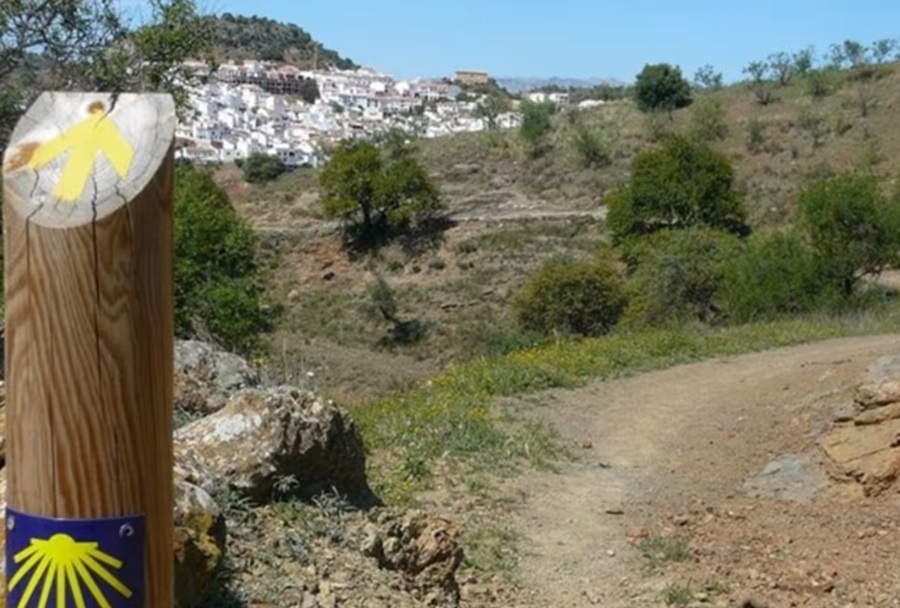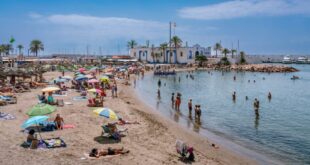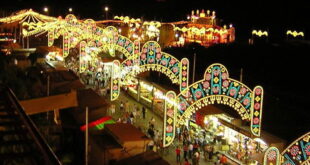Blessed with sweeping landscapes and history spanning millennia, the Camino Mozárabe offers a more solitary and soulful alternative to the busier routes. This walk reveals an entirely different Spain, one that is shaped by Roman streets, Moorish towns, and the timeless rhythms of rural life.
The Mozárabe walk
The name “Mozárabe” refers to the Christians who lived under Muslim rule during the Moorish occupation of Spain. This was a period of cultural fusion and relative coexistence, and the Camino Mozárabe honours that complex heritage. Pilgrims would set off from Al-Andalus, modern-day Andalucía, to connect with northern routes and ultimately reach Santiago.
Today’s Camino Mozárabe The route follows a series of ancient pilgrimage trails that were largely forgotten by the 1990s. Due to the efforts made by local volunteers and associations, the route can now be walked and offers an evocative trip through the spiritual heart of south Spain.
Map of the Camino Mozárabe route. Credit: Ayuntamiento de Baena
From Málaga to Mérida
The Camino Mozárabe begins in Málaga, known for its coastal buzz and Moorish fortress. Within days, pilgrims find themselves leaving the Mediterranean behind, climbing into the Sierra de Málaga. The early part of the route is framed by cork oaks and rugged mountains.
From the sierras, the camino descends into the agricultural heart of Andalucía. The camino passes through Antequera with its Roman roads and ancient dolmens, before crossing the Guadalhorce valley, which is a land filled with citrus groves, grain fields, and Roman roads. The scenery changes again approaching Córdoba, where the Mezquita’s striped arches and patios filled with jasmine and oranges mark a cultural high point.
North of Córdoba, the route continues into Extremadura, a sparsely populated region defined by open landscapes and ancient paths. In Mérida, pilgrims arrive at one of the greatest Roman cities in Spain, where the remains of a theatre, amphitheatre, and aqueduct make it a natural waypoint. Here, the Camino Mozárabe meets the Via de la Plata, a Roman trade route turned pilgrimage path that leads all the way to Galicia.

The Roman theatre in Mérida Image credit: Deborah Cater
Why choose the Camino Mozárabe?
What sets the Camino Mozárabe apart is its sense of solitude and authenticity. Unlike the heavily trafficked Camino Francés or the more touristed coastal routes, this southern camino offers long stretches of unbroken countryside. You can walk for many hours, and even whole days, without meeting another pilgrim.
It’s not a negative. It’s an attraction for many.
Manni Coe is the founder of TOMA & COE and a veteran camino guide, has been walking the Camino Mozárabe for 8 years.
“I’ve been leading groups on the caminos since over 20 years. Since 2017, the routes I have been guiding have been exclusively along the Camino Mozárabe, the route that heads north to Santiago de Compostela from the city of Málaga. “We divided the route in three sections and offered different sections each year.”
One of the greatest advantages of the Camino is its varied landscape. Andalucía’s olive groves stretch to the horizon, punctuated by white villages and forgotten castles. The vast expanses of the Extremaduran Plains provide a meditative, expansive backdrop. The wildlife is plentiful, from Iberian Hares to soaring Eagles. And the seasons change the landscape in ever-changing colours.
Manni considers the Camino to be more than a simple walk. “It encompasses all my favourite things – walking, nature, history, culture, food, wine and friendship. There is no other way for me than to travel through Spain and get a better understanding of the country. “It is the epitome transformational travel.”

Camino signposts along the route. Image credit: Junta de Andalucía
Planning your Camino Mozárabe: Tips for the journey
- Timing Is Important
Spring (March-May) and fall (September-early November) are the best seasons to go walking. Summer temperatures in Andalucía and Extremadura can exceed 40°C, making conditions harsh. - Signage and Logistics
The route is marked in many sections but is less developed than some other caminos. Use GPS and a good guidebook when you can. Plan your accommodation ahead of time. - Fitness and Terrain
Terrain is varied with steep climbs up the sierras and flat, long stretches through farmland. Good walking shoes and a moderate level of fitness are required. - Language and Culture
This is an authentically Spanish camino. The pilgrims will travel through towns with little English spoken. It is important to learn basic Spanish and embrace local customs. - Be self-reliant
Unlike the Camino Francés, services such as cafés, albergues (pilgrim hostels), and shops can be sparse. Bring water, snacks and flexibility. This camino rewards independent travel.
It’s worth the trip
The Camino Mozárabe is not for everyone. It requires more preparation and provides fewer comforts. For those who seek solitude, history and the real rhythm of Spain, this is an unforgettable experience. This is a less traveled path, which holds a certain magic.
Manni Coe explains it this way: “It is impossible to understand and see Spain in any other way.”
 Costa News Spain Breaking News | English News in Spain.
Costa News Spain Breaking News | English News in Spain.





